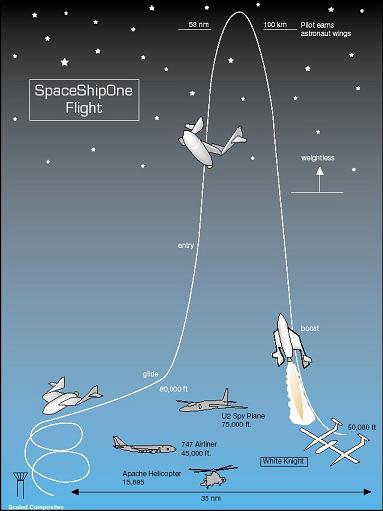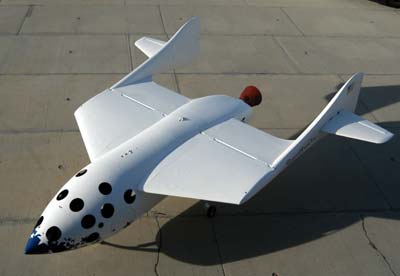
Home
Rocketry
Orbits
Technology
CEV
ISS
X-Prize
Virgin Galactic
RTG
Ion Propulsion
The Ansari X-Prize

In order to encourage breakthroughs in the space-flight industry, the nonprofit X-Prize Foundation offered a $10 million award to the first team to fly a reusable vehicle capable of carrying three people to a minimum altitude of 100 km (62 miles), sub-orbital space, twice in two weeks. Modelled after the early aviation prizes of the 1900s such as the Orteig Prize, which was won by Charles Lindbergh in 1927 for being the first to fly non-stop from New York to Paris, the goal of the ANSARI X-Prize was to competitively stimulate innovation of technologies in this field, as well as get private companies and entrepreneurs involved. It is prizes of this nature that brought about advancements in the aerospace industry and is ultimately responsible for commercial aviation industry that exists today. On October 4th, 2004, Mojave Aerospace Ventures (aerospace designer Burt Rutan and financier Paul Allen) won the 10 million dollar prize with the flight of SpaceShipOne. Their craft soared to 112.2 kilometers (69.7 miles) well exceeding the 62-mile level necessary to win the X Prize. Some of the other twenty-five teams, including the Canadian team, remain committed to launch their flights, despite the X-prize already having been won. For many the capture of the ANSARI X-Prize has marked the beginning of the private space flight revolution, which will one day remove the restrictions of space travel for civilians. Following the success and capture of the ANSARI X-Prize, the X-Prize Cup was announced as an annual event hosted by the X-Prize foundation every October in New Mexico. The X-Prize Cup is an exposition and large-scale spectator event featuring advances in technology. The ultimate goal of the cup is to have multimillion dollar prizes as incentives for continued breakthroughs in sub-orbital operations such as maximum altitude, farthest cross range, and fastest turn around time are expect in the future. New Mexico allocated $9 million to develop the infrastructure, launch and landing facilities necessary to host the competition. Additionally, the state is preparing the Southwest Regional Spaceport in Upham, near Las Cruces, to become the country’s first licensed inland spaceport.

Following the success of the X-Prize, NASA has also allocated money, around $400,000 over two years for competitions to encourage the development of wireless power transmission systems and super-strong tethers. The “Beam Power Challenge” and “Tether Challenge” are NASA's inaugural events in the Centennial Challenge; a competition aimed at providing incentives for technological advances with future space exploration potential. Although NASA is the financier the California-based Spaceward Foundation is responsible for the administrative work. A $50,000 prize is awarded to the first place team in both competitions. Specifically, the “Beam Power Challenge” requires teams to build a robot climber and power-receiving system capable of raising 25 kilograms (55 pounds) up a 50-meter (164-foot) cable, with the power supplied to the climber from a 10-kilowatt searchlight at the bottom of the cable. In the case that multiple teams accomplish this goal the team who’s system handles the most mass, wins. Other technologies that may be apart of future Centennial Challenges are: aerocapture demonstrations, micro re-entry vehicles, robotic lunar soft landers, station-keeping solar sails, robotic triathlon, human-robotic analog research campaigns, autonomous drills, lunar all-terrain vehicles, precision landers, telerobotic construction, power-storage breakthroughs, and radiation-shield breakthroughs.